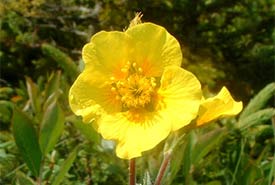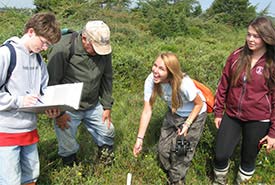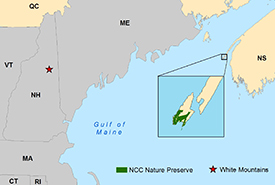Brier Island's eastern mountain avens

Eastern mountain avens (Photo by June Swift)
For most of the year, the eastern mountain avens does its best to hide amongst the peatland vegetation on Brier Island, located at the extreme southwestern edge of Nova Scotia. However at the height of summer, a small buttercup-like flower the size of a quarter extends from palm-sized leaves and reaches high for the sky.
With flowers stems measuring over 30 centimetres in height, the avens becomes visible and conspicuous — an array of bright yellow flowers dotting the wetlands and vying for pollinators.
This display lasts for a short time only. By September the flowers have retreated and the avens has returned to its place amongst the spongy sphagnum. However a new project by the Nature Conservancy of Canada (NCC) and partners is putting eastern mountain avens in the spotlight, hoping to give it a helping hand.
Tiny Brier Island is surrounded by the churning waters of the Bay of Fundy and accessed by not one, but two ferry trips. The island is home to 95 per cent of the entire Canadian population of eastern mountain avens and is one of only two regions in the world where it can be found.
For unknown reasons, alpine meadows and stream banks in the White Mountains of New Hampshire, located some 400 kilometres west, are the only other refuge for this species.
This globally rare species and is one of the primary reasons NCC established the 1,200-acre (485-hectare) Brier Island Nature Preserve in 1988.
Bringing back the eastern mountain avens
Since 2012 NCC has been engaged in an exciting project to reverse habitat degradation in the largest wetland on Brier Island, in an effort to restore habitat for the avens. In the 1950s landowners undertook an aggressive ditching effort to drain the Big Meadow Bog, home to the largest population of the plant on the island (and in Canada), for agricultural purposes.
The legacy of this is a fundamentally altered hydrology, which has resulted in a drying of central portions of the wetland and led to significant changes in the vegetation communities. It has also led to the establishment of the largest colony of nesting gulls in the province.
The gulls compound the problem by introducing significant amounts of nitrogen, phosphorus and calcium into the peatland ecosystem — systems which have naturally low levels of these elements.

Student volunteers with the Gulf of Maine Institute help monitor water levels (Photo by NCC)
To prevent these changes from progressing any further and jeopardizing remnant populations of avens still occurring in the margins of the wetland, NCC has partnered with Nova Scotia Department of Natural Resources, Canadian Wildlife Service, Fern Hill Institute for Plant Conservation, Mersey Tobeatic Research Institute and Acadia University to assess the potential for restoring hydrology and facilitating a return to conditions similar to the pre-ditched wetland.
Restoring habitat for the avens
This is the first peatland restoration effort in Atlantic Canada to focus on restoring habitat for an endangered species. To date, two years of baseline study have amassed a wealth of information on current hydrological conditions in the local watershed, conducted extensive avens population inventory and mapping and investigated gull feeding patterns and movements.
Using electronic recording devices called dataloggers suspended in one metre deep wells, we have gained an understanding of seasonal groundwater fluctuations and by measuring outputs of surface water we have initiated the construction of a model to understand how water moves on the surface of the peatland.
Water quality testing has identified a gradation in the impacts of gull guano, with current nesting areas receiving the highest inputs.
Water is the name of the game here, as the ultimate goal is to keep things wet!
In order to measure the effectiveness of the restoration over time, permanent monitoring plots have been established.
We hope to see a return to plants that characterise peatlands in the area, including a carpet of sphagnum moss, and the wiry deergrass and dwarf woody shrubs like bog laurel and dwarf huckleberry.
Community support for conservation
The Big Meadow Bog has always been a central feature of Brier Island and one used by residents of the picturesque outport town of Westport for generations. Many of those traditional uses such as duck hunting, berry picking and even ice skating have been lost as a result of the changes in the bog. NCC is making community a big part of this project.

Map of the Brier Island Nature Preserve (Photo by NCC)
Local folks are providing input into project decisions and continual efforts are being made to keep the community informed. Longer term, it is hoped that the development of infrastructure to tell the story of the wetland renewal will contribute to the islands nature-based tourism, which is driven by birding and whale watching.
Conserving the lifeblood of the wetland
This winter the partners’ efforts will shift to engineering and physical design considerations. If we are to combat the ongoing changes in the ecosystem, we must have a plan for stopping, or at least slowing, the exit of the lifeblood of any wetland — water.
Renowned peatland restoration expert Jonathan Price from the University of Waterloo visited the site in spring 2014 and provided expert advice.
Price cautioned that restoring complex ecosystems is not a precise activity and that the restoration design must be simple and adaptable. These principles will guide the development of a restoration blueprint in the coming year.
All the attention being paid to this little, inconspicuous plant is notable. The project partners are together advancing a project that has little precedent and upon which the future of a significant portion of the globally available habitat for this species depends.
Our vision of a functioning, healthy wetland complex supporting a robust population of eastern mountain avens is an achievable one and we are confident in our work — good science driving recovery and stewardship efforts.
While it prefers to lay low, it is now time for the eastern mountain avens to shine!
This important work has been generously funded by Environment Canada’s Habitat Stewardship Program, Sage Environmental Program and the Nova Scotia Species at Risk Fund.


